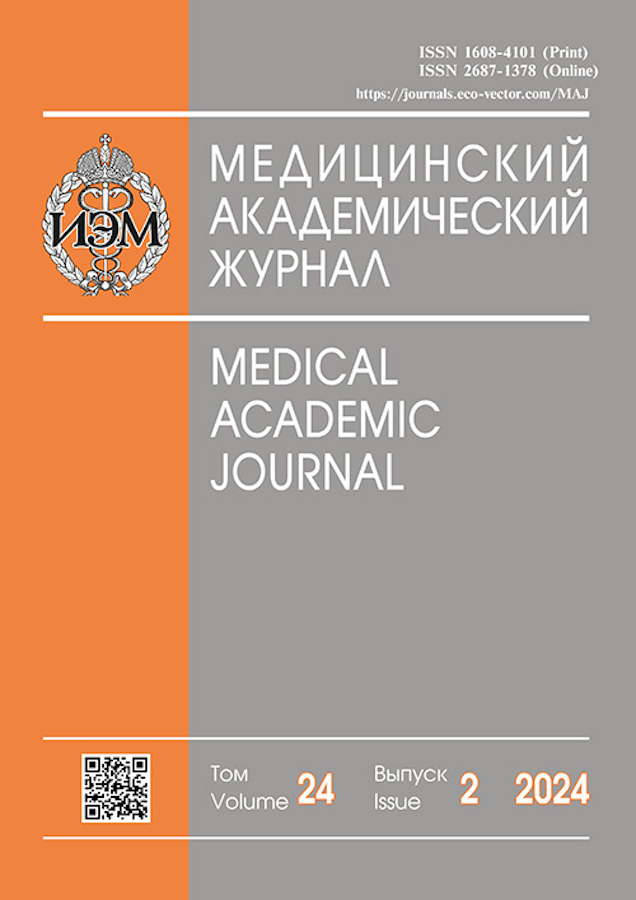Isolation of antibodies to hypochlorite-modified low-density lipoproteins from human serum and study of their specificity
- Authors: Grigoryeva K.N.1,2, Dmitrieva A.A.2, Ivanova A.A.2, Denisenko A.D.2
-
Affiliations:
- Peter the Great Saint Petersburg Polytechnic University
- Institute of Experimental Medicine
- Issue: Vol 24, No 2 (2024)
- Pages: 61-68
- Section: Original research
- Published: 29.10.2024
- URL: https://journals.eco-vector.com/MAJ/article/view/630075
- DOI: https://doi.org/10.17816/MAJ630075
- ID: 630075
Cite item
Abstract
BACKGROUND: Modified low-density lipoproteins have immunogenic properties and induce the production of antibodies. In this case, HOCl promotes the formation of subsequent active halogen-containing compounds interacting with proteins and lipid parts of low-density lipoproteins, which leads to their modification and the production of antibodies to them.
AIM: The aim of this work is to isolate antibodies to hypochlorite modified low-density lipoproteins from human blood sera and study their specificity.
MATERIALS AND METHODS: Malondialdehyde, acetic anhydride and sodium hypochlorite were used to obtain modified low-density lipoproteins. IgG antibodies to hypochlorite modified low-density lipoproteins were isolated by affinity chromatography. The total IgG fraction antibodies was previously isolated from human blood serum using MabSelect Xtra. The specific antibodies to hypochlorite modified low-density lipoproteins were isolated from this IgG pool by affinity chromatography. CNBr-Sepharose 4B conjugated with human serum albumin modified with NaOCl was used as a sorbent. The specificity of antibodies against hypochlorite modified low-density lipoproteins was tested using a competitive enzyme-linked immunosorbent assay. The competitors were hypochlorite modified low-density lipoproteins, acetic anhydride modified low-density lipoproteins and malondialdehyde modified low-density lipoproteins in concentrations (1–250 μg/ml).
RESULTS: IgG antibodies against hypochlorite-modified proteins that interact with hypochlorite modified low-density lipoproteins were detected in human blood. According to ELISA date the binding of the isolated antibodies to hypochlorite modified low-density lipoproteins was almost completely inhibited only by appropriately modified low-density lipoproteins, that is, hypochlorite modified low-density lipoproteins, but not native low-density lipoproteins or acetic anhydride modified low-density lipoproteins. Malondialdehyde modified low-density lipoproteins also showed some competitive activity, but much weaker than hypochlorite modified low-density lipoproteins. Hypochlorite modified low-density lipoproteins itself and, to a lesser extent, malondialdehyde modified low-density lipoproteins competed for binding with antibodies of human serum to hypochlorite modified low-density lipoproteins. Acetic anhydride modified low-density lipoproteins and native low-density lipoproteins did not reduce the efficiency of antibody binding to their antigen.
CONCLUSIONS: Hypochlorite modified low-density lipoproteins forms epitopes independent of other low-density lipoproteins modifications studied. These epitopes are responsible for the formation of specific antibodies.
Full Text
About the authors
Ksenia N. Grigoryeva
Peter the Great Saint Petersburg Polytechnic University; Institute of Experimental Medicine
Email: ks_grigorieva24@mail.ru
ORCID iD: 0009-0005-3818-9835
Student
Russian Federation, Saint Petersburg; Saint PetersburgAlexandra A. Dmitrieva
Institute of Experimental Medicine
Email: aleksandra-2001@mail.ru
ORCID iD: 0000-0003-2680-4069
SPIN-code: 3009-2698
Junior Researcher of the Department of Biochemistry
Russian Federation, Saint PetersburgAnna A. Ivanova
Institute of Experimental Medicine
Author for correspondence.
Email: anna.ivantcova@gmail.com
ORCID iD: 0000-0002-8673-9628
SPIN-code: 5306-1995
Junior Researcher of the Department of Biochemistry
Russian Federation, Saint PetersburgAlexander D. Denisenko
Institute of Experimental Medicine
Email: add@iem.sp.ru
ORCID iD: 0000-0003-1613-0654
SPIN-code: 7496-1449
MD, Dr. Sci. (Medicine), Professor, Head of the Laboratory of Regulation of Lipid Metabolism
Russian Federation, Saint PetersburgReferences
- Denisenko AD. Autoimmune lipoprotein-antibody complexes and their role in atherogenesis. Medical Academic Journal. 2007;7(1):38–44. EDN: HZRKAP
- Pigarevsky PV, Archipova OYu, Denisenko AD. Detection of modified lipoproteins in atherosclerotic lesions of human aorta. Medical Immunology (Russia). 2006;8(5–6):637–644. EDN: IIXJPL doi: 10.15789/1563-0625-2006-5-6-637-644
- Belik IV, Ivantsova AA, Mamedova ZE, et al. Antibodies against modified low-density lipoproteins and their complexes in blood of patients with various manifestations of atherosclerosis. Biochemistry Suppl Ser B Biomed Chem. 2016;10(4):346–350. EDN: WIBNHN doi: 10.18097/PBMC20166204471
- Denisenko AD, Vinogradov AG, Dizhe EB, Sukonina VE. Antilipoprotein autoantibodies (Aab), lipoprotein-antibody immune complexes (Lp-Ab IV) and atherosclerosis. In: Advances in Lipoprotein and Atherosclerosis Research, Diagnostics and Treatment. Proceedings of the 10th International Dresden Lipid Symposium; December 9–11, 1999; Dresden. P. 75–79.
- Malle E, Waeg G, Schreiber R, et al. Immunohistochemical evidence for the myeloperoxidase/H2O2/halide system in human atherosclerotic lesions: colocalization of myeloperoxidase and hypochlorite-modified proteins. Eur J Biochem. 2000;267(14):4495–4503. doi: 10.1046/j.1432-1327.2000.01498.x
- Schindhelm RK, van der Zwan LP, Teerlink T, et al. Myeloperoxidase: a useful biomarker for cardiovascular disease risk stratification? Clin Chem. 2009;55(8):1462–1470. doi: 10.1373/clinchem.2009.126029
- Sokolov AV, Kostevich VA, Runova OL, et al. Proatherogenic modification of LDL by surface-bound myeloperoxidase. Chem Phys Lipids. 2014;180:72–80. doi: 10.1016/j.chemphyslip.2014.02.006
- Hazell LJ, van den Berg JJ, Stocker R. Oxidation of low-density lipoprotein by hypochlorite causes aggregation that is mediated by modification of lysine residues rather than lipid oxidation. Biochem J. 1994;302(Pt 1):297–304. doi: 10.1042/bj3020297
- Kopprasch S, Leonhardt W, Pietzsch J, et al. Hypochlorite-modified low-density lipoprotein stimulates human polymorphonuclear leukocytes for enhanced production of reactive oxygen metabolites, enzyme secretion, and adhesion to endothelial cells. Atherosclerosis. 1998;136(2):315–324. doi: 10.1016/s0021-9150(97)00233-5
- Havel RJ, Eder HA, Bragdon JH. The distribution and chemical composition of ultracentrifugally separated lipoproteins in human serum. J Clin Invest. 1955;34(9):1345–1353. doi: 10.1172/JCI103182
- Markwell MA, Haas SM, Bieber LL, et al. A modification of the Lowry procedure to simplify protein determination in membrane and lipoprotein samples. Anal Biochem. 1978;87(1):206–210. doi: 10.1016/0003-2697(78)90586-9
- Palinski W, Ylä-Herttuala S, Rosenfeld ME, et al. Antisera and monoclonal antibodies specific for epitopes generated during oxidative modification of low-density lipoprotein. Arteriosclerosis. 1990;10(3):325–335. doi: 10.1161/01.atv.10.3.325
- Fields R. The rapid determination of amino groups with TNBS. Methods Enzymol. 1972;25:464–468. doi: 10.1016/S0076-6879(72)25042-X
- Smith PK, Krohn RI, Hermanson GT, et al. Measurement of protein using bicinchoninic acid. Anal Biochem. 1985;150(1):76–85. doi: 10.1016/0003-2697(85)90442-7
- Hawkins CL, Pattison DI, Davies MJ. Hypochlorite-induced oxidation of amino acids, peptides and proteins. Amino Acids. 2003;25(3–4):259–274. doi: 10.1007/s00726-003-0016-x
Supplementary files










